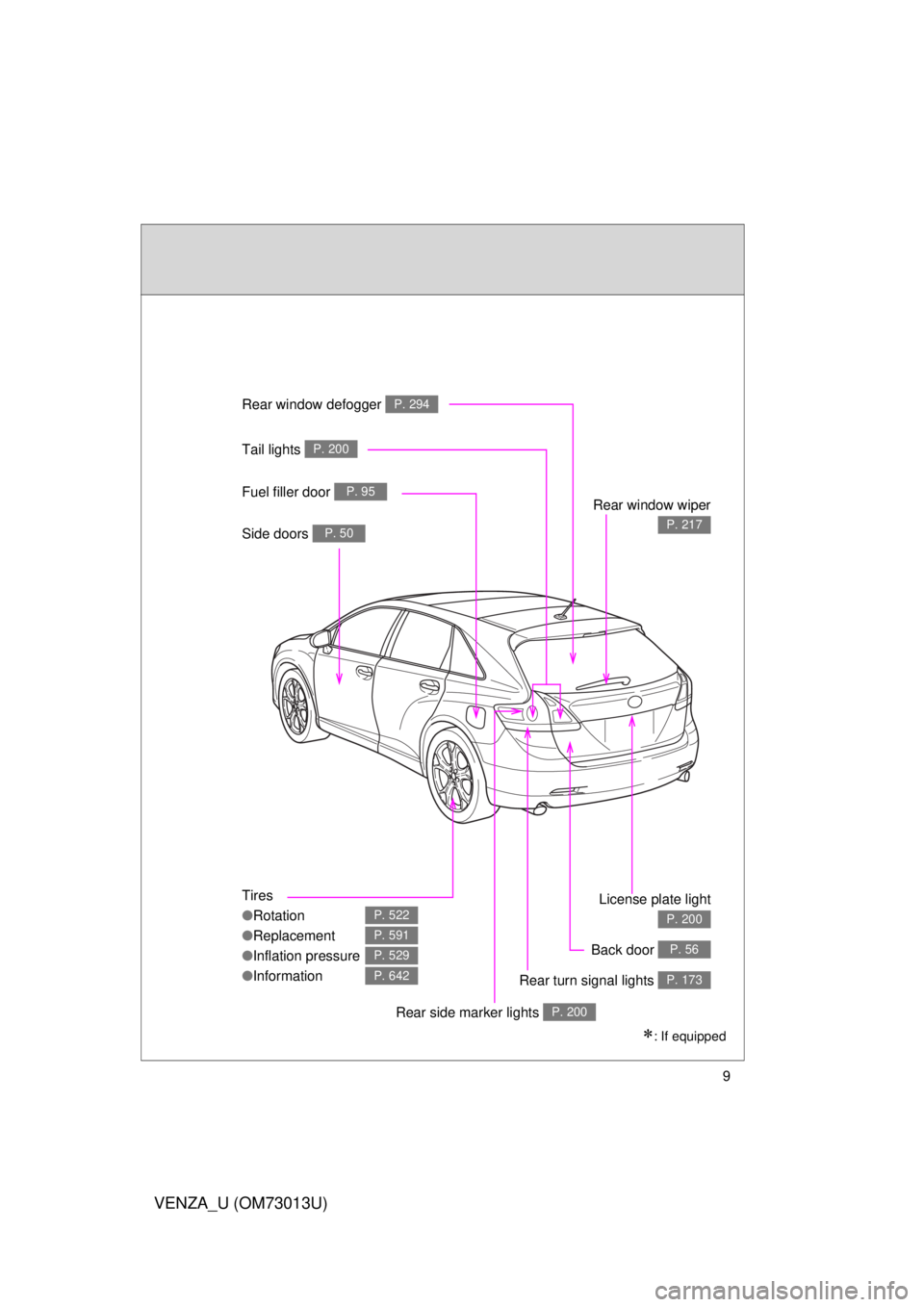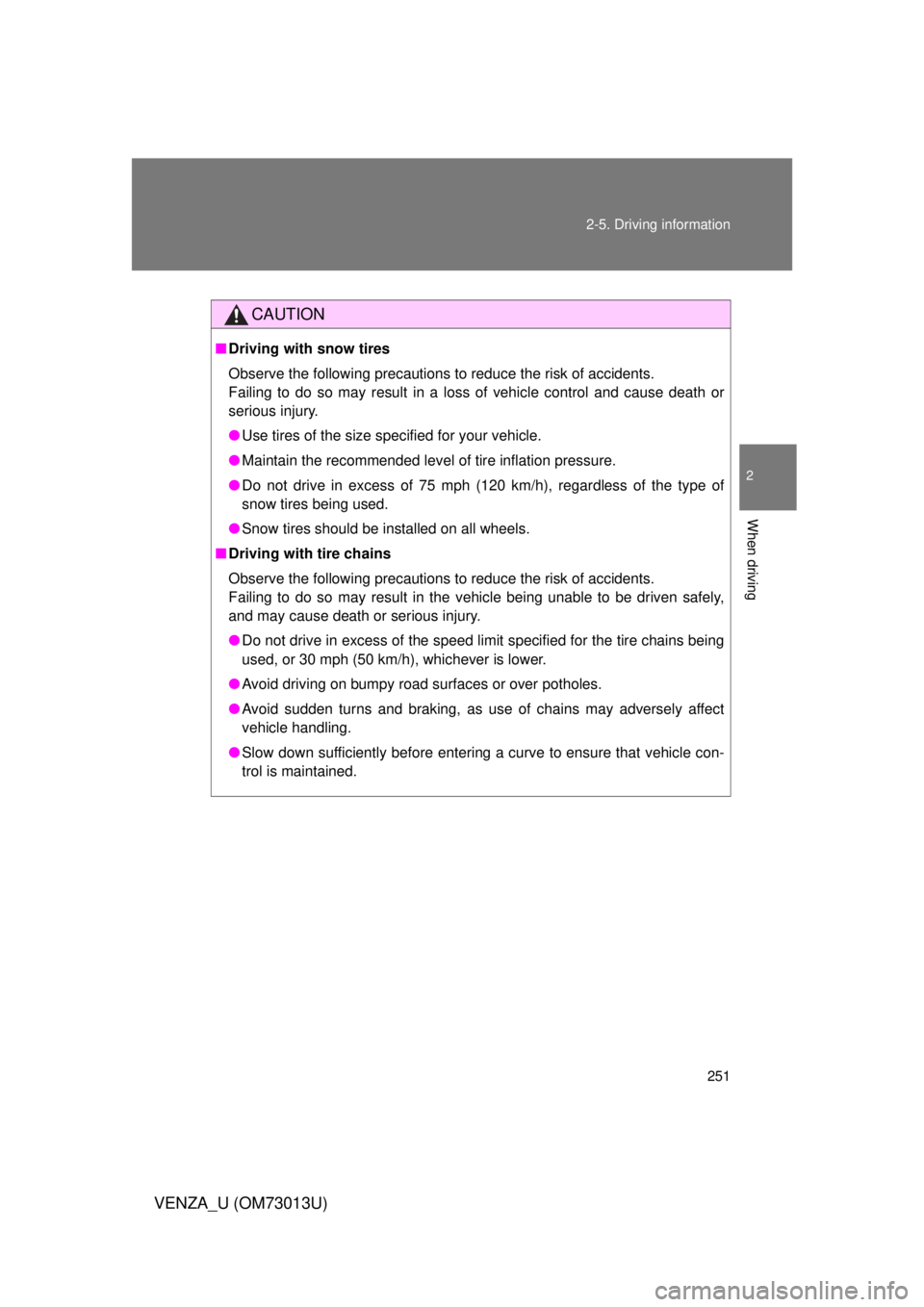flat tire TOYOTA VENZA 2012 Owners Manual (in English)
[x] Cancel search | Manufacturer: TOYOTA, Model Year: 2012, Model line: VENZA, Model: TOYOTA VENZA 2012Pages: 700, PDF Size: 12.2 MB
Page 1 of 700

TABLE OF CONTENTS
1
VENZA_U (OM73013U)
1Before drivingAdjusting and operating features such as door locks,
mirrors, and steering column
2When drivingDriving, stopping and safe-driving information
3Interior
featuresAir conditioning and audio systems, as well as other in-
terior features for a comfortable driving experience
4Maintenance
and careCleaning and protecting your vehicle, performing do-it-
yourself maintenance, and maintenance information
5When trouble
arisesWhat to do if the vehicle needs to be towed, gets a flat
tire, or is involved in an accident
6Vehicle
specificationsDetailed vehicle information
7For ownersReporting safety defects for U.S. owners, and seat belt
and SRS airbag instructions for Canadian owners
IndexAlphabetical listing of information contained in this
manual
Page 5 of 700

1
2
3
4
5
6
7
5
VENZA_U (OM73013U)
3-6. Using the interior lightsInterior lights list .................. 446
• Personal/interior light main switch ....................... 447
• Personal/interior lights ...... 448
• Luggage compartment light ................................... 448
3-7. Using the storage features List of storage features ....... 450
• Glove box.......................... 451
• Console boxes .................. 452
• Overhead console............. 454
• Cup holders ...................... 455
• Bottle holders .................... 457
• Auxiliary boxes.................. 458
3-8. Other interior features Sun visors ........................... 461
Vanity mirror........................ 462
Power outlets ...................... 463
Seat heaters........................ 466
Armrest ............................... 468
Floor mats ........................... 469
Luggage compartment features ............................. 471
Garage door opener............ 473
Compass ............................. 480 4-1. Maintenance and care
Cleaning and protecting the vehicle exterior ........... 486
Cleaning and protecting the vehicle interior ............ 489
4-2. Maintenance Maintenance requirements .................... 492
General maintenance ......... 495
Emission inspection and maintenance (I/M)
programs .......................... 498
4-3. Do-it-yourself maintenance Do-it-yourself service precautions....................... 499
Hood ................................... 503
Positioning a floor jack ....... 505
Engine compartment .......... 507
Tires ................................... 522
Tire inflation pressure ......... 529
Wheels ............................... 533
Air conditioning filter ........... 536
Key battery ......................... 539
Checking and replacing fuses................................. 543
Light bulbs .......................... 553
4Maintenance and care
Page 6 of 700

TABLE OF CONTENTSIndex
6
VENZA_U (OM73013U)
5-1. Essential informationEmergency flashers ........... 568
If your vehicle needs to be towed .......................... 569
If you think something is wrong ............................ 573
If noise can be heard from under vehicle .................... 574
Fuel pump shut off system .............................. 575
5-2. Steps to take in an emergency If a warning light turns on or a warning buzzer
sounds... ......................... 576
If a warning message is displayed .......................... 590
If you have a flat tire ........... 591
If the engine will not start .................................. 602
If the shift lever cannot be shifted from “P”................. 605
If you lose your keys .......... 606
If the electronic key does not operate properly
(vehicles with smart key
system) ............................ 607
If the battery is discharged ....................... 610
If your vehicle overheats .... 615
If the vehicle becomes stuck................................. 618
If your vehicle has to be stopped in an
emergency ....................... 620 6-1. Specifications
Maintenance data (fuel, oil level, etc.) ........... 624
Fuel information .................. 638
Tire information................... 642
6-2. Customization Customizable features ........ 657
6-3. Initialization Items to initialize ................. 664
Reporting safety defects for U.S. owners ................. 666
Seat belt instructions for Canadian owners
(in French) ........................ 667
SRS airbag instructions for Canadian owners
(in French) ........................ 669
5When trouble arises6Vehicle specifications
7For owners
Page 9 of 700

9
VENZA_U (OM73013U)
Tires
●Rotation
● Replacement
● Inflation pressure
● Information
P. 522
P. 591
P. 529
P. 642
Rear window defogger P. 294
Rear window wiper
P. 217
Tail lights P. 200
Side doors P. 50
Rear turn signal lights P. 173
License plate light
P. 200
Back door P. 56
: If equipped
Fuel filler door P. 95
Rear side marker lights P. 200
Page 160 of 700

160 2-1. Driving procedures
VENZA_U (OM73013U)
NOTICE
■If you get a flat tire while driving
A flat or damaged tire may cause the following situations. Hold the steering
wheel firmly and gradually press the brake pedal to slow down the vehicle.
● It may be difficult to control your vehicle.
● The vehicle will make abnormal sounds.
● The vehicle will behave abnormally.
Replace a flat tire with a new one. ( P. 591)
■ When encountering flooded roads
Do not drive on a road that has flooded after heavy rain etc. Doing so may
cause the following serious damage to the vehicle.
● Engine stalling
● Short in electrical components
● Engine damage caused by water immersion
In the event that you drive on a flooded road and the vehicle is flooded, be
sure to have your Toyota dealer check the following.
● Brake function
● Changes in quantity and quality of oil and fluid used for the engine, tran-
saxle, transfer (AWD models), differential (AWD models), etc.
● Lubricant condition for the propeller shaft (AWD models), bearings and
suspension joints (where possible) and the function of all joints, bearings,
etc.
Page 208 of 700

208 2-3. Operating the lights and wipers
VENZA_U (OM73013U)
●In the situations below, the system may not be able to correctly detect the
surrounding brightness levels, and may flash or expose nearby pedestri-
ans to the high beam. Therefore, you should consider turning the high
beam on or off manually rather than relying on the Automatic High Beam
system.
• In bad weather (rain, snow, fog, sandstorms etc.)
• The windshield is obscured by fog, mist, ice, dirt etc.
• The windshield is cracked or damaged.
• The inside rear view mirror or ca mera sensor is deformed or dirty.
• Surrounding brightness levels are equal to those of headlights, tail lights or fog lights.
• Vehicles ahead have headlights that are either switched off, dirty, are changing color, or are not aimed properly.
• When driving through an area of intermittently changing brightness and darkness
• When frequently and repeatedly driving ascending/descending roads, or roads with rough, bumpy or uneven surfaces (such as stone-paved
roads, gravel tracks etc.)
• When frequently and repeatedly taking curves or driving on a winding road
• There is a highly reflective object ahead of the vehicle, such as a sign or a mirror.
• The vehicle’s headlights are damaged or dirty.
• The vehicle is listing or tilting, due to a flat tire, a trailer being towed etc.
• The Automatic High Beam indicator is flashing.
• The high beam and low beam are repeatedly being switched between in an abnormal manner.
• The driver believes that the high beam may be causing problems or distress to other drivers or pedestrians nearby.
Page 226 of 700

226 2-4. Using other driving systems
VENZA_U (OM73013U)
■Setting the rear view monitor system displays
Vehicles with navigation system
”Navigation System Owner’s Manual”
Vehicles without navigation system
P. 190
CAUTION
■ When using the rear view moni tor system, observe these precautions
to avoid an accident that could r esult in death or serious injuries.
● Never depend solely on the monitor system when reversing.
● Always check visually and with the mirrors to confirm your intended path is
clear.
● Depicted distances between objects and flat surfaces differ from actual
distances.
● Do not use the system if the back door is not completely closed.
● Do not use the system when using tire chains or the compact spare tire.
Page 235 of 700

235
2-4. Using other
driving systems
2
When driving
VENZA_U (OM73013U)
CAUTION
■When TRAC and Enhanced VSC are off
Be especially careful and drive at a speed appropriate to the road condi-
tions. As there are systems to ensure vehicle stability and driving force, do
not turn off TRAC and Enhanced VSC unless necessary.
■ When the Enhanced VSC is activated
The slip indicator light flashes. Always drive carefully.
Reckless driving may cause an accident. Exercise particular care when the
indicator light flashes.
■ Replacing tires
Make sure that all tires are of the same size, brand, tread pattern and total
load capacity. In addition, make sure that the tires are inflated to the speci-
fied tire pressure level.
The ABS and Enhanced VSC will not function correctly if different tires are
fitted on the vehicle.
Contact your Toyota dealer for further information when replacing tires or
wheels.
■ Handling of tires and suspension
Using tires with any kind of problem or modifying the suspension will affect
the driving assist systems, and may cause the system to malfunction.
■ Active Torque Control 4WD system
● The AWD system of this vehicle is intended to ensure driving stability on
normal roads. It is not designed for use in demanding situations such as
rally driving.
● Take care when driving on slippery road surfaces.
Page 251 of 700

251
2-5. Driving information
2
When driving
VENZA_U (OM73013U)
CAUTION
■
Driving with snow tires
Observe the following precautions to reduce the risk of accidents.
Failing to do so may result in a loss of vehicle control and cause death or
serious injury.
● Use tires of the size specified for your vehicle.
● Maintain the recommended level of tire inflation pressure.
● Do not drive in excess of 75 mph (120 km/h), regardless of the type of
snow tires being used.
● Snow tires should be installed on all wheels.
■ Driving with tire chains
Observe the following precautions to reduce the risk of accidents.
Failing to do so may result in the vehicle being unable to be driven safely,
and may cause death or serious injury.
● Do not drive in excess of the speed limit specified for the tire chains being
used, or 30 mph (50 km/h), whichever is lower.
● Avoid driving on bumpy road surfaces or over potholes.
● Avoid sudden turns and braking, as use of chains may adversely affect
vehicle handling.
● Slow down sufficiently before entering a curve to ensure that vehicle con-
trol is maintained.
Page 265 of 700

265
2-5. Driving information
2
When driving
VENZA_U (OM73013U)
Trailer towing tips
Your vehicle will handle differently when towing a trailer. Help to avoid
an accident, death or serious injury, keep the following in mind when
towing:
● Speed limits for towing a trailer vary by state or province. Do not
exceed the posted towing speed limit.
● Toyota recommends that the vehicle-trailer speed limit is 65 mph
(104 km/h) on a flat, straight, dry road. Do not exceed this limit, the
posted towing speed limit or the speed limit for your trailer as set
forth in your trailer owner’s man ual, whichever is lowest. Instability
of the towing vehicle-trailer combin ation (trailer sway) increases as
speed increases. Exceeding speed limits may cause loss of con-
trol.
● Before starting out, check the trailer lights, tires and the vehicle-
trailer connections. Recheck after driving a short distance.
● Practice turning, stopping and reve rsing with the trailer attached in
an area away from traffic until you become accustomed to the feel
of the vehicle-trailer combination.
● Reversing with a trailer attached is difficult and requires practice.
Grip the bottom of the steering wheel and move your hand to the
left to move the trailer to the left. Move your hand to the right to
move the trailer to the right. (Thi s is generally opposite to reversing
without a trailer attached.) Avoid sharp or prolonged turning. Have
someone guide you when reversing to reduce the risk of an acci-
dent.
● As stopping distance is increased when towing a trailer, vehicle-to-
vehicle distance should be increased. For each 10 mph (16 km/h) of
speed, allow at least one vehicle and trailer length.
● Avoid sudden braking as you may skid, resulting in the trailer jack-
knifing and a loss of vehicle control. This is especially true on wet
or slippery surfaces.